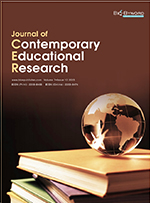Analysis of the Factors Influencing the Participation of University Students in Rural Education for Poverty Alleviation
Abstract
The principle of “poverty alleviation first helps the poor” is fundamental to poverty alleviation through education in rural areas. It serves as an important foundation for improving the soft power of rural culture and promoting the development of rural cultural construction. However, college students, being one of the main participants in educational poverty alleviation, have not been equipped with a well-established institutionalized participation mechanism and a sufficient awareness of participation. To enhance college students’ awareness and participation in rural education and poverty alleviation and to improve the institutionalization, this research focuses on college students as a group, delves into the current situation and willingness of college students to participate in rural education and poverty alleviation, and analyzes the influencing factors affecting college students’ participation in rural education and poverty alleviation by means of a questionnaire and a computerized statistical algorithm. Lastly, based on mathematical and statistical analysis, the research puts forward corresponding optimization countermeasures and suggestions from the perspectives of the government, colleges and universities, and villages, so as to provide decision-making guidelines for solving the problems of rural education development and talent constraints.
References
Yang Z, Zhen L, Heng W, et al., 2023, Targeted Poverty Alleviation Narrowed China’s Urban-Rural Income Gap: A Theoretical and Empirical Analysis. Applied Geography, 2023(157): 10300.
Hu T, Sun M, 2022, A Visualization Analysis of Poverty Alleviation Through Education Research in China. Cogent Social Sciences, 8(1): 2132674.
Ling RF, 2012, Statistical Methods for Digital Computers (Enslein K, Ralston A, Wilf HS, eds.). SIAM Review, 21(2): 276–277.
Ahmad IMZ, Nazrin MJ, Hasanain GF, et al., 2021, A Unique Double Tango: Construct Validation and Reliability Analysis of Risk Perception, Attitude and Practice (RPAP) Questionnaire on Dengue Infection. PloS One, 16(8): e0256636.
Izzaty D, Rodi MI, Wee XC, et al., 2023, Development of the Malay Language of Understanding, Attitude, Practice and Health Literacy Questionnaire on COVID-19 (MUAPHQ C-19): Content Validity Face Validity Analysis. BMC Public Health, 23(1): 1131.
Zakariya YF, 2022, Cronbach’s Alpha in Mathematics Education Research: Its Appropriateness, Overuse, and Alternatives in Estimating Scale Reliability. Frontiers in Psychology, 2022(13): 1074430.
Khan NN, Ganai NA, Ahmad T, et al., Morphometric Indices of Native Sheep Breeds of the Himalayan Region of India Using Multivariate Principal Component Analysis. Zygote (Cambridge, England), 31(2): 1–6.
de Souza RR, Toebe M, Mello AC, et al., 2023, Sample Size and Shapiro-Wilk Test: An Analysis for Soybean Grain Yield. European Journal of Agronomy, 2023(142): 126666.
Cheng L, Lu Z, Zhang L, 2015, New Spearman Correlation Based Sensitivity Index and Its Unscented Transformation Solutions. Journal of Engineering Mechanics, 142(2): 04015076.
Helmy R, Steven B, Augie W, et al., 2023, Image Encoding Selection Based on Pearson Correlation Coefficient for Time Series Anomaly Detection. Alexandria Engineering Journal, 2023(82): 304–322.

